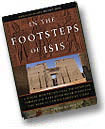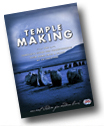

THE SOUND OF CROP CIRCLES
Accounts from the 80 eyewitnesses who’ve seen crop circles manifesting describe a trilling sound prior to or during the manifestation of crop circles. This unusual noise, which is described as sounding like a cross between a cicada and a waterfall, was eventually captured on magnetic tape in 1989 during a night watch of a field at Cheesefoot Head, England, by a group of researchers.
It was duly sent to NASA’s Jet Propulsion Laboratory in Pasadena, CA, where it was brought to the attention of Robert Weiss, the man who had previously analyzed the famous Watergate Tapes. He concluded that the noise was not related to any type of bird or insect. In fact, due to its looping, rhythmic nature, it appeared to be of intelligent, mechanical origin. Further, it contained a frequency of 5.0-5.2 kHz.

Interestingly, Australian Aborigines have been imitating the crop circle trilling sound for generations. During ceremonies to contact their “sky spirits”, the Aborigines attach a specially-shaped piece of wood called bora to the end of a long string. It is whirled around, creating a noise practically identical to the crop circle sound. Research later revealed that not only have crop circles appeared in Australia, but they are also described in Aboriginal myths, just as their geometries appear in ancient Aboriginal rock paintings.
In the 1950s, American agricultural researcher George Smith found that exposing cornstalks to sound produced a higher heat content in its soil, as well as a slight burnt appearance at the base of the stalks. Such effects are consistent with the effects found in crop circles, where the soil is always noticeably drier—in some cases even baked—than the rest of the field, and the affected stalks are slightly charred just above the soil.
Oddly enough, Smith speculated that particular sound frequencies actually increased molecular activity in plants. Three decades later, tests performed by physicist Dr. W. Levengood have proved that whatever energy is creating crop circles is affecting seed embryo and plant growth by interfering with the plants’ natural growth cycle. This energy also elongates the plants’ nodes and even alters their crystalline structure (the plants’ form at a molecular level).


Conversant with discoveries by Russian scientists throughout the 1930s that certain sound frequencies noticeably affected the growth of both plants and seeds, in the 1960s Mary Measures and Paul Weinberger at the University of Ottawa, Canada, succeeded in accelerating growth in wheat by playing sound to the plants. But the sound also produced a resonant effect in the plants’ cells, thereby affecting their metabolism. And the frequency which created these effects was identical to the crop circle trilling noise: 5 kHz.
Perhaps the greatest connection linking sound to the manifestation of crop circles, however, lies in their greatest anomaly: the permanent bending of the plants' stems. In 1968, laboratory experiments at Temple Buell College, CO, measured the effects of music on plants by subjecting them to different tones. Exposure to heavy metal music made the plants tilt away from the speakers or die, whereas classical music lulled the plants to lean toward the speakers. But in the case of Hindu devotional music, the stems bent in excess of 60° to the vertical and towards the speakers, perhaps the closest anyone has ever come to recreating the right-angle bend found in the plant stems in genuine crop circles.
Interestingly, applications of Indian devotional song to plants during the 1930s at Annamalai University, India, also showed a number of similar biophysical changes to those which occur in plants analyzed by Dr. Levengood, as mentioned earlier.
CREATING A CROP CIRCLE
Sound, then, may be capable of creating crop circles. But how does it achieve those highly complex designs found in crop circles today? This can be achieved by ultrasound.
Ultrasound can be aimed like a laser beam, and such focusing allows for certain kinds of molecules to vibrate while others nearby are left unmoved. This is due to the frequencies inherent in ultrasound – frequencies the MHz range which, thanks to their very narrow wavebands, have the ability to hone in on a specific area.
Evidence of such high frequencies have been detected inside crop circles since 1991 by the researcher Paul Vigay, whose custom-built electronic device has measured readings which generally range between 260 and 320 MHz. Vigay’s research also found that, since 1996, the frequencies detected inside crop circles have increased to 640 MHz, even 1.2 GHz, which coincides with the increased geometric complexity of the designs themselves. This mirrors Jenny's experiments, which show that a relationship exists between the complexity of cymatic geometries and the dispensed sound frequencies. In other words, the higher the frequency, the greater the geometric intricacy.
The high frequencies common to ultrasound are known to affect states of awareness in humans, and visitors to crop formations often report an inability to properly perform analytical or left brain functions. In fact, a number of Japanese scientists who’ve conducted monitored EEG tests inside crop circles show how there is a tendency for the intuitive or right brain to be far more active in people when they are within the space of a crop circle. It is interesting to compare this effect with Neolithic sacred spaces, namely standing stones and stone circles, which have a long history of association with altered states of awareness. Experiments to monitor energy fields in standing stones during the 1970s in England by Dan Robbins revealed that these sacred stones emit ultrasonic frequencies.
Because ultrasound operates within a specific bandwidth, it can be used as a sensitive tool that prevents damage to sensitive tissue, again by focusing its frequencies on a specific area rather than the whole. Consequently, it is today used in healing, particularly in the treatment of muscular ailments. The parallel to crop circles lies in the way the delicate plants have been manipulated with and yet show no visible signs of damage. What’s more, hundreds of people have reported being healed after interacting with crop circles – either by visiting one or by looking at a photograph. This includes a long-time sufferer of Parkinson’s, who experienced the complete absence of shaking, and a person with a 99% malignant eye tumor, who saw the tumor shrivel away after ingesting the seeds from a crop circle.
Below 20 Hz, sound becomes infrasonic. Such low frequencies influence biological processes because they resonate physical objects at the molecular level. Experiments throughout the 1980s at Princeton’s P.E.A.R laboratory demonstrate that, when combined with high air pressure, the acoustic power of infrasound can boil water inside a hollow cavity in one nanosecond (called “vapor cavitation”).
As water heats it expands. In the case of crop circles plants, if one looks closely at the affected stems, one can see tiny holes in their nodes (the plant’s “knuckles”), indicating that the boiled water has expanded and blown outwards through the nodes - at which point the base of the stems become as supple as molten glass, enabling the plants to collapse under their own weight into their extreme horizontal position.

The rapid boiling of the water tallies with Levengood's discovery of microscopic blow-holes in the plants' cell wall pits which indicates a rapid boiling of water inside the plant has taken place. The low frequencies of infrasound can tear water molecules apart, atomizing them into a fine mist. Farmers in both England and Canada have witnessed columns of mist rising from within newly-arrived crop circles, suggesting this process is indeed at play in the fields.
The lower the operating frequency of infrasound, the greater its effect on physical elements. Below 18 Hz the acoustic pressure formed by infrasound is known to disrupt chromosomes. Every summer, plants from crop circles and normal agricultural plots are sent to Dr. Levengood. The samples are blind-tested so as to conceal their exact origin, a standard scientific protocol to prevent the tampering of laboratory tests. And after thousands of tests, Levengood consistently finds unmistakable disruption to the chromosomes of plants taken from crop circles.

A CHANGE IN CONSCIOUSNESS
The ancients once held sound to be the prime creator of matter in the Universe, yet we have had to wait, in modern times, for individuals such as Hans Jenny to provide a measured understanding of what sound looks like and how it behaves. Given our knowledge of how sound can not only influence plants and the molecules of the physical world but also the awareness of a human being, is it possible that, in the crop circles, we are witnessing energy forms capable of arousing the spirituality in humanity?
Sound, when modelled into music, becomes a powerful carrier for social change – the effects of Handel's music is believed to have reversed the state of morality in Victorian England, just as the anarchic overtones of Punk corralled disillusioned youth into fighting an establishment that held no tolerance for those who stepped outside its rules. It is through music that human experiences are celebrated and carried forward from generation to generation.
Perhaps it's no coincidence that a large percentage of crop circle designs can be identified with, and by, ancient cultures who to this day honour their histories through song and music, their healing rituals performed with sound. This relationship is applied in Buddhist mandalas, whose elaborate geometries are used to alter states of consciousness. Certainly it is no coincidence that crop circle designs mirror these intricate patterns, just as they bear an uncanny familiarity to Jenny's materializations of sound.
If sound is one of the formative principles behind crop circles, they are not only leaving behind physical clues in the plants, but also creating a change in awareness on those whose antenna is extended and receptive to their tune. There is no doubt that our present worldview is undergoing tumultuous change, and at such times, the collective subconscious of humanity reaches out for guidance. Because our thoughts are electromagnetic pulses which transcend time and space, it is possible that our request has been received, and information is manifesting in fields around the world.
Using sound as a foundation of crop circles is the most direct form of communication, because sound is capable of affecting the resonant fields within intercellular processes down into the genetic levels, even down into the subatomic levels. Suggestive and rhythmic commands aimed at people while they listen to music is already an efficient method of absorbing information and knowledge. Coupled to ultrasonic frequencies, this technique can alter brainwave patterns, inducing the mind into a meditative and receptive state.
Text © Freddy Silva 1997, 2002. No reproduction without prior permission.





 |
|||||||